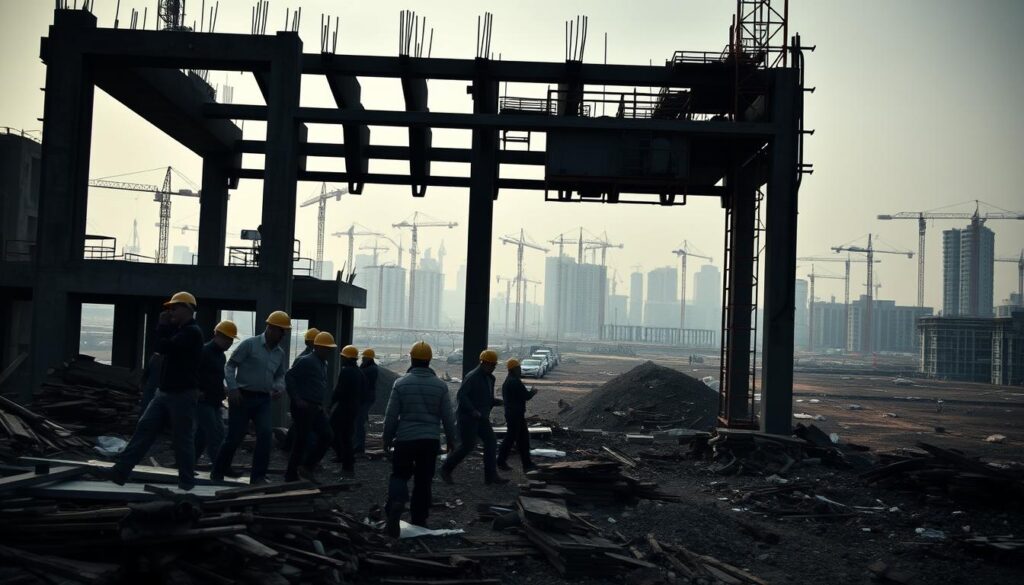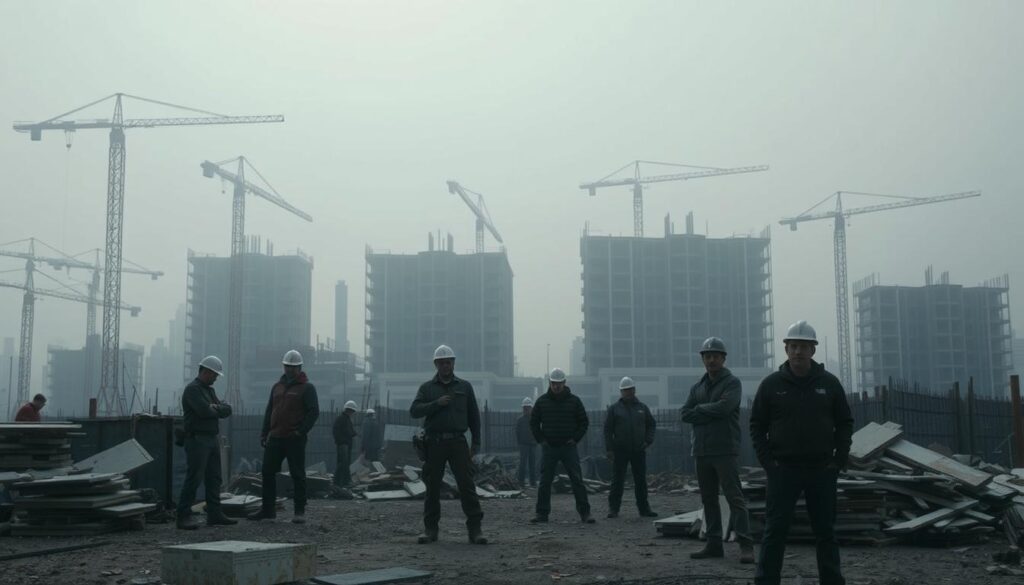Starting a building project in Houston comes with unique challenges. Recent data from adminX (September 16, 2024) reveals that 25% of local developments face setbacks, often tied to workforce shortages and extreme weather. Understanding these obstacles helps homeowners and investors make smarter decisions.
Scheduling conflicts frequently arise when teams struggle to secure skilled workers. Delays worsen when hurricanes or floods disrupt timelines, especially during peak seasons. Supply chain bottlenecks and permit approvals add months to completion dates, straining budgets and trust between stakeholders.
These issues don’t just affect timelines—they impact profits and professional reputations. For example, contractors risk losing future opportunities if projects stall repeatedly. Buyers and investors need reliable partners who anticipate these hurdles.
New Homes Houston Texas offers decades of experience navigating Houston’s complex real estate landscape. For tailored solutions, call (954) 821-4492 or visit their Houston, TX office. Their team provides actionable strategies to keep developments on track, rain or shine.
Key Takeaways
- 25% of Houston projects face delays due to labor shortages and weather disruptions
- Supply chain challenges and permit processes extend timelines by months
- Delays harm contractor reputations and investor returns
- Proactive planning minimizes weather-related risks
- Local expertise ensures smoother project execution
Understanding the Landscape of Houston Construction Delays
The complexity of Houston’s construction sector is shaped by multiple local factors. Regulatory bottlenecks and material shortages create ripple effects across timelines. A 2024 Houston Contractors Association study found 15% of delays stem from permit approvals alone, while supply chain gaps add 3-6 weeks to schedules.

Industry Challenges and Local Conditions
Houston’s subtropical climate brings unpredictable storms, forcing teams to build weather buffers into schedules. Coordination between contractors and subcontractors often breaks down when handling specialized jobs. For example, electrical work delays can stall plumbing installations, creating cascading setbacks.
Statistical Insights on Project Delays
Data reveals three critical patterns:
- 42% of projects exceed deadlines due to overlapping trade schedules
- Material delivery times increased 18% since 2023
- Smaller developments face 23% more delays than commercial builds
These trends highlight why proactive planning matters. Later sections will outline strategies to streamline workflows and reduce downtime.
Labor Shortages and Workforce Issues
Houston’s building boom faces a critical hurdle: not enough skilled hands. Recent NCCER data shows 1 in 4 projects now experience delays tied to staffing gaps. Contractors report shrinking applicant pools as veteran workers retire faster than replacements arrive.

Skilled Labor Deficit in Houston
The local workforce shrinks while demand grows. Over 30% of electricians and welders in the area will reach retirement age by 2026. This creates bottlenecks when specialized tasks pile up. A U.S. Bureau of Labor Statistics study found Houston projects take 17% longer to staff than the national average.
Strategies to Enhance Workforce Management
Forward-thinking firms invest in apprenticeship programs to cultivate talent early. Others use digital scheduling tools to optimize crew rotations. For example, ABC Construction reduced delays by 40% after adopting real-time labor tracking software.
Cross-training teams for multiple roles prevents single-point dependencies. Partnering with vocational schools also builds reliable talent pipelines. These steps keep projects moving even when skilled workers are scarce.
Weather Conditions Impacting Construction Schedules
Houston’s skies often dictate timelines more than project managers do. The region averages 49.8 inches of annual rainfall—nearly double the U.S. norm—according to National Weather Service data. This creates a constant race against nature for crews working on tight deadlines.

Subtropical Climate Pressures
High humidity and sudden storms complicate outdoor work for 6-8 months yearly. Hurricane Harvey (2017) flooded over 200 active sites, delaying projects by 12-18 weeks. Even routine downpours can:
- Submerge equipment and materials
- Erode unstable soil on unfinished sites
- Force crews to halt work for safety
Adapting to Weather Risks
Forward-thinking teams now use flood-resilient designs like elevated foundations and permeable paving. Real-time weather tracking apps help adjust schedules before storms hit. One Harris County developer reduced weather delays by 34% using these tactics.
| Weather Event | Average Delay | Mitigation Strategy |
|---|---|---|
| Hurricanes | 3-6 weeks | Pre-storm site hardening |
| Floods | 2-4 weeks | Drainage system upgrades |
| Heavy Rainfall | 1-3 weeks | Weather-resistant materials |
While no one controls the forecast, smart planning minimizes disruptions. As one project manager notes: “Building here means respecting the weather—it’s not an obstacle, just another blueprint line item.”
Supply Chain and Material Shortage Challenges
Material availability shapes timelines as much as blueprints in modern building projects. McKinsey Global Institute reports a 30% increase in delivery times since 2022, while Associated General Contractors (AGC) data shows material costs spiking 22% year-over-year. These pressures hit harder when global bottlenecks collide with regional limitations.
Disruptions in Material Delivery and Inventory
Delayed shipments of steel, lumber, and electrical components now rank among top delay triggers. A 2024 AGC survey found:
- 57% of contractors rerouted shipments due to port closures
- Concrete shortages stalled 1 in 3 Texas projects last year
- Roofing material wait times doubled since 2021
One Houston developer lost 11 weeks waiting for European-made HVAC units, forcing costly design changes mid-project.
Impact of Global and Local Supply Chain Issues
Global events like shipping strikes create ripple effects, but Houston’s rapid growth strains local networks too. Key challenges include:
| Issue Type | Example | Solution |
|---|---|---|
| Global | Asian port delays | Dual-source materials |
| Local | I-45 construction bottlenecks | Regional supplier partnerships |
Forward-thinking firms now order critical materials 6-8 months ahead. Others use AI tools to predict shortages – ABC Builders cut inventory gaps by 40% using this approach.
“You can’t outwork a missing beam,” notes a project manager at a top Houston firm. Agile sourcing turns supply chain risks into manageable variables.”
Regulatory, Permitting, and Compliance Hurdles
Navigating Houston’s regulatory maze adds unexpected layers to project timelines. The Houston Planning and Development Department reports average permit approval times of 45-90 days—twice the national benchmark for similar-sized cities. This bottleneck often stems from overlapping reviews by multiple agencies, creating a domino effect for developers.

Cumbersome Permitting Processes in Houston
Local general contractors face three core challenges:
- Environmental impact assessments requiring TCEQ approvals (delays 22% of projects)
- Zoning variance requests taking 8-12 weeks to process
- Last-minute code updates from the 2024 International Building Code adoption
The American Bar Association notes that 68% of compliance disputes arise from misaligned city and county regulations. One high-rise developer lost 14 weeks resolving fire safety code conflicts between Houston and Harris County standards.
Adapting to Changing Building Codes and Regulations
Proactive project management teams now implement these control strategies:
- Engage permit expediters during design phases
- Conduct quarterly code compliance audits
- Use AI tools to flag regulation changes in real-time
As one project lead shared: “Treating compliance as a living process—not a checklist—cuts approval times by half.” Firms adopting this approach reduced rework costs by 31% in 2024, per Texas Construction Association data.
Design Changes, Rework, and Financial Pressures
Last-minute design shifts can derail even well-planned builds. Construction Industry Institute research shows 35% of projects face delays due to revisions, with client requests ranking as the top catalyst. These alterations ripple through timelines and budgets, creating compounding challenges for teams.
Client-Initiated Modifications and Rework Challenges
A homeowner’s decision to expand a kitchen mid-project often forces electricians and plumbers to redo work. Associated Builders and Contractors found such changes add 18-26 days to schedules and spike labor costs by 15%. Each change order triggers:
- Material waste from canceled orders
- Overtime payments for rushed adjustments
- Potential errors during rushed implementations
Cost Overruns and Budgetary Impacts
ABC data reveals 22% of projects exceed initial budgets due to design mistakes. A 2024 case study showed a commercial developer lost $287,000 revising floor plans three times. Financial pressures escalate when:
| Issue | Average Cost Increase | Time Impact |
|---|---|---|
| Structural revisions | 12-18% | 3-5 weeks |
| Finishing changes | 7-9% | 1-2 weeks |
Proactive teams now use 3D modeling software to visualize designs early, reducing late-stage changes by 40%. As one project manager notes: “Freezing designs before breaking ground saves more than time—it preserves trust.”
Technology and Equipment in Mitigating Delays
Modern tools reshape how teams tackle timelines. A 2024 Dodge Data & Analytics study shows firms using digital solutions cut rework by 33% and boost progress rates by 41%. These innovations turn unpredictable variables into manageable workflows.
Construction Management Software Advantages
Platforms like Procore and Autodesk BIM 360 centralize scheduling, budgeting, and communication. Cloud-based tools let supervisors track progress across multiple sites in real time. For example:
- One Texas developer reduced inspection delays by 28% using automated permit tracking
- AI-powered risk analysis tools predict material shortages 60 days in advance
| Software Type | Productivity Gain | Delay Reduction |
|---|---|---|
| BIM Systems | 27% | 19% |
| Resource Management | 34% | 22% |
Modernizing Equipment for Reliability
Telematics in machinery alerts crews before breakdowns occur. A Houston firm slashed equipment downtime by 51% after upgrading to IoT-enabled excavators and cranes. Key benefits include:
- Predictive maintenance schedules based on usage data
- GPS tracking for faster stolen equipment recovery
“Outdated tools create invisible bottlenecks,” notes a project lead at a top regional contractor. “Smart upgrades pay for themselves within two projects.”
Investing in these solutions builds resilience against unexpected setbacks. Teams adopting both software and equipment innovations report 39% fewer timeline overruns annually.
What Causes New Construction Delays Houston
Builders face multiple overlapping challenges when executing developments in Southeast Texas. Three core issues emerge from industry analysis: workforce gaps, environmental pressures, and logistical bottlenecks. Each factor interacts with others, creating compounding effects on schedules.

Key Causal Factors from Expert Insights
Leading contractors identify these primary timeline disruptors:
- Workforce gaps: 31% of projects report skilled labor shortages (NCCER 2024)
- Extreme weather: 62 annual rainy days delay outdoor work (National Weather Service)
- Material shortages: 45-day average wait for electrical components (AGC survey)
Permitting delays add 6-11 weeks to starts, while design changes during builds increase costs by 18%. These issues often occur simultaneously, as seen when a 2023 mixed-use development faced:
- Concrete delivery delays
- Unexpected drainage code updates
- Subcontractor scheduling conflicts
Practical Strategies for Delay Mitigation
Proactive teams implement these evidence-based solutions:
| Challenge | Strategy | Result |
|---|---|---|
| Labor shortages | Partner with trade schools | 27% faster staffing |
| Weather risks | Pre-storm site hardening | 34% fewer delays |
| Supply chain gaps | Dual-source critical materials | 41% inventory reliability |
Digital tools prove essential – 68% of contractors using scheduling software meet deadlines more consistently. As one project lead notes: “Anticipating problems beats reacting to emergencies. Our weather tracking system saved 19 project days last year.”
Regular compliance audits and contingency budgets help teams adapt when unexpected issues arise. These approaches turn potential setbacks into manageable workflow adjustments.
Navigating New Construction Delays in Houston: Key Takeaways
Successfully navigating Houston’s dynamic building environment demands strategic foresight. Workforce gaps, material shortages, and unpredictable weather patterns remain top disruptors, as shown by recent industry data. Projects leveraging real-time scheduling tools and contingency plans demonstrate 34% fewer setbacks compared to traditional approaches.
Proactive management separates successful developments from stalled ones. Integrating weather-resistant designs, dual-sourcing critical supplies, and partnering with compliance experts reduces rework risks. Teams adopting these methods report 27% faster staffing and 41% improvement in material reliability.
Local knowledge proves invaluable when balancing timelines with budget constraints. New Homes Houston Texas combines decades of regional experience with cutting-edge project controls. For tailored strategies that keep builds on track, call (954) 821-4492. Their team transforms complex challenges into streamlined progress—ensuring your investment delivers results, not delays.





